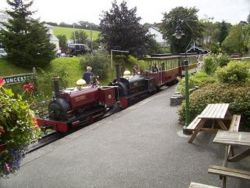Launceston Steam Railway
The Launceston Steam Railway is a 1 ft 111⁄2 in (597 mm) narrow gauge railway in Cornwall, based in Launceston. Trains run for 2½ miles to Newmills, where there is a farm park.
The first railway to reach Launceston was the Launceston and South Devon Railway, opened in 1865 from Launceston to Plymouth, and later absorbed into the Great Western Railway. In 1886 the London and South Western Railway opened its railway from Halwill Junction, extended to Padstow in stages in the 1890s, and later part of the Southern Railway. The two Launceston stations were side by side: the Great Western closed in 1962 and the Southern in 1966.
The LSR starts just west of the LSWR station, which is now an industrial estate. In 1965, Nigel Bowman rescued the steam locomotive Lilian from the Penrhyn Slate Quarry in North Wales, and restored her to working order. He then began to look for somewhere to run hern, and by 1971 it had been decided to build the LSR. Purchase of the trackbed and building the railway took a long time from the initial idea, and the first trains ran on Boxing Day 1983 on a half-mile stretch of track. Since then, extensions have been made to bring the line to its current length, along with building a new station and acquiring more locomotives and rolling stock.
The LSR is unusual in that every public service is run using steam locomotives - most heritage railways use diesels on some dates. The four steam locomotives used were all built by the Hunslet Engine Company for slate quarries in North Wales. The carriages are based on those built of the Manx Electric Railway, Torrington and Marland Railway and the Plynlimon and Hafan Tramway. In addition, there is a Motor Rail Simplex diesel locomotive and two inspection trolleys built on site.
It is a long term plan to extend the railway a further 2 miles to the village of Egloskerry.
External link

